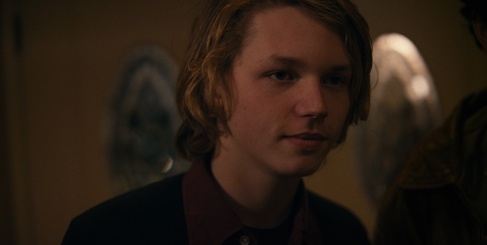Finally, here are the Top 15 films from 2013 you must definitely see!

1. THE ACT OF KILLING
Joshua Oppenheimer
There is no film like The Act of Killing and I doubt there will be another. It’s possibly the most evil film ever made, but also one of the most important.
Indonesia 1965. A Western-backed anti-communist purge leads to the slaughter of half a million people by the hands of local gangsters. Living comfortably today in their elder years, they have never been tried for a single murder and the community celebrates what they’ve done. Director Joshua Oppenheimer finds a handful of them, including Anwar Congo, who personally claimed to strangle 1,000 people with wire.
Oppenheimer proposes they re-enact their killings on camera in the style of Hollywood genre films. No one dies of course, but sets, lighting, make up and special effects are used to dramatize the slaughter. As a group of friends, together they play all the roles.
So we watch as mobster scenes, exotic musicals and monstrous horror films are surreally intercut with his own interviews with each gangster.
Astonishingly, while we watch them distort definitions of “human rights” and “war crimes” to justify their actions, the formative power of filmmaking appears to change them. Or at least it seems to with Anwar, after his nightmares are realized and he plays a murder victim in a few scenes.
The final scene in The Act of Killing is the most perplexing and profound sequence you will see all year. Is it real, or is it pretend? We were comfortable in labelling them as monsters, and kept a healthy distance from them. But now what? Are we more bothered by the idea that they might not be?
Because it redefines again what cinema can do; because it’s a wake up call to the West; because these people are real, The Art of Killing is the best film of 2013 -by an unprecedented margin.

2. LIKE SOMEONE IN LOVE
Abbas Kiarostami
Iranian ex-pat Kiarostami’s second feature outside his homeland takes us to Tokyo and bends cinema as only he can. To pay for school, young Akiko’s works as a call girl and tonight, despite dodging phone calls from her possessive boyfriend, she will be sent to entertain the retired grandfathery university professor, Mr. Watanabe. Through the film’s run Kiarostami constantly makes decisions that subvert our genre expectations. Cruel actions are ambiguous, or given a lightness of touch; relationships shift wildly between harmful and innocent, and the growing threat of violence is all but ignored until the film’s literal last second. That final moment counts though, and in a film that comments on our expectations of relationships in life, and in fiction, that last shatter of glass speaks volumes.

3. MUSEUM HOURS
Jem Cohen
Anne travels from Montreal to Vienna to visit a distant cousin who’s near death. Alone in the city with not much money, she spends her days in the city’s Museum of Art History where she befriends a guard, Johan. With their only connection being the museum, the two enjoy relaxed conversations about art and its relationship to the world around them. It may seem dry, but Jan Cohen asks us to consider the values we place on the events, people and objects in our everyday lives. Anna’s story about comforting her cousin is one of many that will grace the halls of the museum, and her story will fade unlike the works around her that are deemed “priceless” and “masterpieces,” but Cohen dares to question why it is this way. After we learn the humble origins of timeless artists, we’re left wondering if they felt their lives to be much like Anna’s. Best of all Cohen edits and frames his shots with this philosophy in mind, randomly cutting between works of art and beautiful (if sometimes jarring) compositions of the good and the bad in modern Vienna.

4. INSIDE LLEWYN DAVIS
Joel and Ethan Cohen
Poor Llewyn can’t catch a break. The titular struggling folk artist, couch surfing between friends in 1960 Greenwich Village, is trying to get a name for himself following the death of his musical partner. Nothing’s going as it should, partly because of the cruelness of the world and partly because of his own doing. Warts and all, the Cohen brothers are constantly in Llewyn’s corner, but what’s remarkable is how they maintain our deepest sympathies even as the film’s timeline turns abstract and scenes dip in their trademark surrealism. The idiosyncratic filmmaking brothers who have found success and fortune by never compromising know too well that for most artists, it will never go that way. They’ve made a film that celebrates artistic failure. Even though it seems like damnation in purgatory, the state of Llewyn’s father suggests that for him, the choice could be far, far worse.

5. THE WORLD’S END
Edger Wright
Edger Wright’s latest genre mash-up is his best yet. That it manages to be his most heavy, and most silly is a testament to his strengths as a genre director. Simon Pegg’s loser Gary hasn’t amounted to anything after his glorious high school days and he’s determined now to bring his friends back to their home town, to complete the pub crawl they failed to as teens. What follows is an epic satire of alien invasion, unfinished affairs and middle-age failure. The World’s End works because Wright cares as much about bullying, alcoholism and suicide attempts as he does about giant robots and blue alien goo.

6. BEFORE MIDNIGHT
Richard Linklater
Over a decade since we last left Jesse and Celine in Before Sunset we find them together, with two new daughters and deep into the dredges of a long term relationship. Luckily there’s still time for walking and talking about the history and philosophy that colours their surroundings, and their relationship, this time on vacation with friends in Greece. But now the happy possibilities of romance that intoxicated the first entries in the Before trilogy have been replaced by something more real, darker, but also more meaningful. Linklater takes our favorite couple to the edge, examining how over time, small disagreements, compromises, and character flaws nip away at a romantic ideal. That ideal, so well demonstrated in the previous films are only enhanced by contrast here in Midnight. Fighting through their years together in one explosive hotel room fight, the trio expose the complete core of “true love.”

7. FRANCES HA
Noah Baumbauch
Part Woody Allen, part French New Wave, Noah Baumbauch and Greta Gerwig’s delightful Frances Ha chronicles those difficult first steps when you’re young and out of school and unsure where to no next. Poor Frances is a dancer struggling to land a company when her best friend and roommate decides to move in with her boyfriend, a decision that rocks Frances’ steady world. A character study of a bright yet slightly insecure girl discovering for the first time the world is messy and always changing, Gerwig is always up to the task, carefully giving us a character who’s both sweet and annoying. It’s one of the best performances of the year.

8. THE WOLF OF WALL STREET
Martin Scorsese
It’s Leonardo DiCaprio fifth ride out for Scorsese, but in many ways, this is his best performance. In this three hour rush of indulgence and insanity, the two give us the rise and fall of corrupt 90’s stockbroker Jordan Belfort and Scorsese puts his lead through the absolute ringer. However, the director doesn’t let himself off the hook, directing a film that would have exhausted many, each scene reveals such dazzling filmmaking range. A pitch black comedy and satire on the American financial structure, with more than a little affection for its bad boy, the film swerves through elaborately orchestrated parties and orgies, intimate character scenes, busy police procedurals, slap stick physical comedy -even a yacht-in-a-storm SFX action sequence. Once again Scorsese has mined cinema and delivered a meal of a film that moves breathlessly and puts imitators to shame. A great time at the movies.

9. BLUE IS THE WARMEST COLOUR
Abdellatif Kechiche
Rare has coming of age and first love been so intimately and vividly accounted as in Kechiche’s depiction of the relationship between Emma and Adele. Over a sprawling three hours Kechiche interprets this romance as a sweeping epic, its landscape: the face of actress Adele Exarchopolous. The camera almost never leaves her close-up, and for the film’s majority we are tight in on her every emotion. She never balks in a single scene and it’s through her talent that Kechiche sells his thesis: love is epic, its effects are massive and ever lasting, and though you may not have had to venture far, when it’s done, you’ve felt like you’ve walked miles.

10. THE HUNGER GAMES: CATCHING FIRE
Francis Lawrence
Who would have thought director Francis Lawrence could have given The Hunger Games the urgency and relevance so missing in its the first film. While it doesn’t resolve the moral problems of the first film, as much as side steps around them and keeps moving forward, the sequel creates no new ones, and exponentially improves itself on every level. From performances, production and direction, Catching Fire lifts the series out of its YA trappings and gives it a much needed immediacy. Ahead of everything of course, is Jennifer Lawrence, who delivers once again.

11. THE WIND RISES
Hayao Miyazaki
Miyazaki’s self-proclaimed final film follows real life Japanese engineer Jiro Horikoshi, who designed fighter planes between the two World Wars. Stricken with bad eye sight, Jiro’s desire to fly grounds him to become an aeoronutical engineer, but in his dreams he soars to the skies along with his mentor Caproni, the Italian designer who joins him in the film’s many stunning fantasy sequences. Caproni desired to build planes for the people, but in WWI the Italian government used them to drop bombs instead. The threat of Jiro’s art being twisted into weapons of destruction permeates every moment in The Wind Rises, but Miyazaki doesn’t let it overwhelm. Despite the fascist climate of Jiro’s trip to Nazi Germany, and its growing presence in his own Japan, (combined with tuberculoses outbreaks, and the Kanto earthquake of 1923), the film is entirely dedicated to the pure innocence of Jiro’s desire to create something beautiful in this world. The film’s final post-WWII dream sequence is a bittersweet lament, one that seems to double as a comment on Miyazaki’s art existing in our turmultuous world.

12. COMPUTER CHESS
Andrew Bujalski
It’s early in the 1980’s and these, the first generation of geek, gather in a run down hotel with their enormous computers to pit each other’s chess software in the lamest tournament in history. What starts out as a mockumentary filmed with a period appropriate Sony AVC tube video camera soon descends into a surreal Altmanesque ensemble piece full of government spies, hotel-hallway labyrinths, sexual frustrations and quite possibly a robotic take over. Even the Sony camera itself seems to turn against the film. Computer Chess celebrates vivid imaginations on tight budgets, it’s unlike anything you’ve seen and in its own hilarious way shows our relationship with technology in the past, present and future.

13. PHILOMENA
Stephen Fears
Young Philomena had her child taken from her after an unwanted pregnancy and disgraced, her family sends her to live in a Catholic convent. She watches her son adopted out to Americans and now, in her elder years she wonders what became of him. Her only help is Martin, a disgraced former journalist eager for any human interest story, and through their journey together, Fears is always careful to balance the film’s tones. What could have been easily neutered sentimental piece, turns into a pointed attack on the Catholic Church, wrapped in a tea-cosey. Helping the film is Dench, in an amazing performance of a woman who teeters between wisdom and naïveté, and Fears own inspired and subtle direction. His mise-en-scene reveals Philomena’s deep crisis of faith without it overwhelming the humor. Philomena will fire your anger and make you chuckle and its brilliance lies is how it measures and succeeds at both.

14. ALL IS LOST
J.C. Chandor
Robert Redford gives it his all in Chandor’s All is Lost. Alone at sail in the Indian Ocean, a collision with a shipping container will set off a fight for survival and confront him with his own mortality. As the film contains almost no dialogue, Chandor cleanly and precisely directs the action, using smart edits and visuals to orient the viewer. Working for the film is its stripped down minimalism, with out even a name, let alone a back story, Redford’s hero refrains from being bogged down in manipulative melodrama. In this way he becomes, “Our Man.” -any one of us, alone to face death, the elements and ourselves.

15. THE COUNSELOR
Ridley Scott
What the heck is The Counselor? It’s a mad, flawed and frustrating, but at times an uncompromising and brilliant crime saga. Though it’s competently shot by Ridley Scott, the overwhelming prescience in the film is the voice of its screenwriter, Cormac McCarthy. With seemingly little use for the rules of filmmaking, McCarthy abandons what bores him and replaces it with a slow, sinister meditation on the existence of evil, and what that means to the film’s players, and to us its audience. In doing so the film is filled with mad non-sequiturs, characters that all talk the same, and an empty nothing of a protagonist that threatens to grind everything to a halt. Still, despite its faults the film’s overwhelming sense of dread cannot easily be shaken, and if you can remember that McCarthy is more interested in the diamonds, cheetahs, parallel realities and the bolero, you will find access to The Counselor.














































